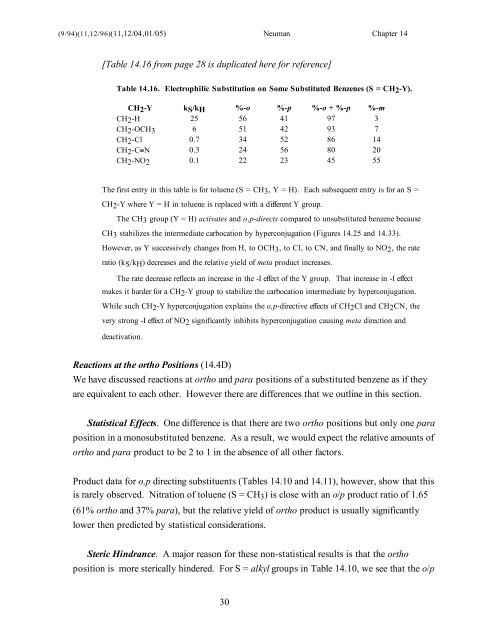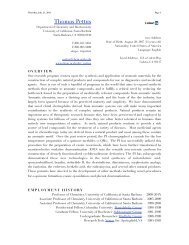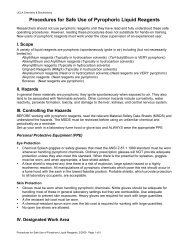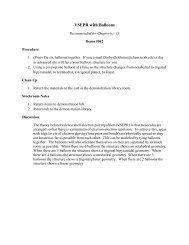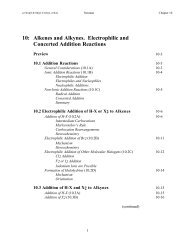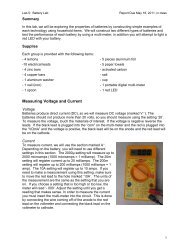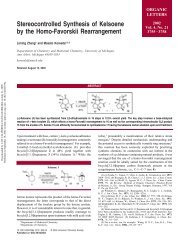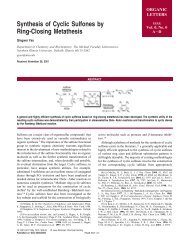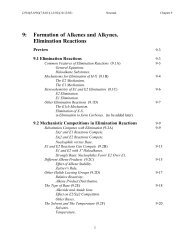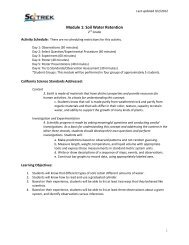14: Substituent Effects
14: Substituent Effects
14: Substituent Effects
You also want an ePaper? Increase the reach of your titles
YUMPU automatically turns print PDFs into web optimized ePapers that Google loves.
(9/94)(11,12/96)(11,12/04,01/05) Neuman Chapter <strong>14</strong><br />
[Table <strong>14</strong>.16 from page 28 is duplicated here for reference]<br />
Table <strong>14</strong>.16. Electrophilic Substitution on Some Substituted Benzenes (S = CH2-Y).<br />
CH2-Y kS/kH %-o %-p %-o + %-p %-m<br />
CH2-H 25 56 41 97 3<br />
CH2-OCH3 6 51 42 93 7<br />
CH2-Cl 0.7 34 52 86 <strong>14</strong><br />
CH2-C≡N 0.3 24 56 80 20<br />
CH2-NO2 0.1 22 23 45 55<br />
The first entry in this table is for toluene (S = CH3, Y = H). Each subsequent entry is for an S =<br />
CH2-Y where Y = H in toluene is replaced with a different Y group.<br />
The CH3 group (Y = H) activates and o,p-directs compared to unsubstituted benzene because<br />
CH3 stabilizes the intermediate carbocation by hyperconjugation (Figures <strong>14</strong>.25 and <strong>14</strong>.33).<br />
However, as Y successively changes from H, to OCH3, to Cl, to CN, and finally to NO2, the rate<br />
ratio (kS/kH) decreases and the relative yield of meta product increases.<br />
The rate decrease reflects an increase in the -I effect of the Y group. That increase in -I effect<br />
makes it harder for a CH2-Y group to stabilize the carbocation intermediate by hyperconjugation.<br />
While such CH2-Y hyperconjugation explains the o,p-directive effects of CH2Cl and CH2CN, the<br />
very strong -I effect of NO2 significantly inhibits hyperconjugation causing meta direction and<br />
deactivation.<br />
Reactions at the ortho Positions (<strong>14</strong>.4D)<br />
We have discussed reactions at ortho and para positions of a substituted benzene as if they<br />
are equivalent to each other. However there are differences that we outline in this section.<br />
Statistical <strong>Effects</strong>. One difference is that there are two ortho positions but only one para<br />
position in a monosubstituted benzene. As a result, we would expect the relative amounts of<br />
ortho and para product to be 2 to 1 in the absence of all other factors.<br />
Product data for o,p directing substituents (Tables <strong>14</strong>.10 and <strong>14</strong>.11), however, show that this<br />
is rarely observed. Nitration of toluene (S = CH3) is close with an o/p product ratio of 1.65<br />
(61% ortho and 37% para), but the relative yield of ortho product is usually significantly<br />
lower then predicted by statistical considerations.<br />
Steric Hindrance. A major reason for these non-statistical results is that the ortho<br />
position is more sterically hindered. For S = alkyl groups in Table <strong>14</strong>.10, we see that the o/p<br />
30


